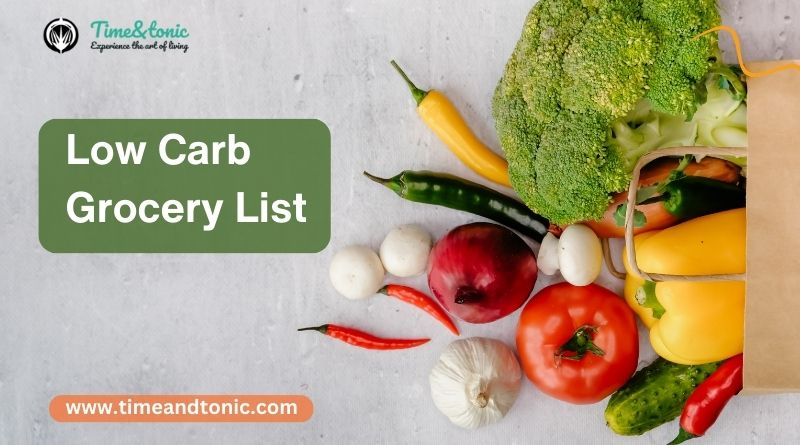Fuel Your Health with Low Carb Grocery List
Welcome to the ultimate guide to crafting a healthier lifestyle through the power of a Low Carb Grocery List. In a world inundated with processed foods and sugary temptations, making mindful choices about what you put into your body has never been more crucial. Embracing a low carb diet is not just a trend; it’s a commitment to your well-being.
This comprehensive Low Carb Grocery List is your passport to a world of nutritious, delicious, and satisfying meals. Whether you’re embarking on a weight loss journey, managing diabetes, or simply striving for better health, understanding the art of low carb shopping is your key to success. Here, we delve deep into the essential components of a low carb diet, from proteins and vegetables to healthy fats and smart snacking options.
Get ready to explore a variety of low carb foods that will tantalize your taste buds, energize your body, and keep you on track toward your health goals. Let’s embark on this transformative journey together, armed with knowledge, motivation, and a carefully curated Low Carb Grocery List.
Also Read: Low-Carb Healthy Recipes
What Are Low Carb Diets
Low carb diets, also known as low carbohydrate diets, are dietary plans that focus on reducing the intake of carbohydrates. Carbohydrates are one of the three main macronutrients found in food, the others being fats and proteins. Low carb diets typically emphasize the consumption of foods that are high in protein and healthy fats while limiting or avoiding foods that are rich in carbohydrates, especially simple carbohydrates and sugars.
The primary goal of low carb diets is to control insulin levels in the body. When you consume carbohydrates, they are broken down into sugar (glucose) in the bloodstream, leading to an increase in insulin production.
Benefits of Low Carb Diets
Low carb diets offer a range of benefits, making them popular among individuals seeking to improve their health, lose weight, or manage certain medical conditions. Here are some of the key benefits of low carb diets:
- Effective Weight Loss: One of the primary reasons people adopt low carb diets is their effectiveness in promoting weight loss. By reducing carbohydrate intake, the body shifts to burning stored fat for energy, leading to significant weight loss, particularly in the initial phases.
- Improved Blood Sugar Control: Low-carb diets are advantageous for those with type 2 diabetes or those who are at risk of developing the disease because they can help stabilize blood sugar levels. By limiting carbohydrate intake, there are fewer spikes in blood sugar and insulin levels, promoting better glucose control.
- Reduced Triglycerides: Low carb diets have been shown to lower triglyceride levels in the blood. Elevated triglycerides are a risk factor for heart disease, so reducing them through a low carb diet can improve heart health.
- Increased HDL (Good) Cholesterol: Low carb diets can raise levels of high-density lipoprotein (HDL) cholesterol, often referred to as “good” cholesterol. Higher levels of HDL cholesterol are associated with a reduced risk of heart disease.
- Improved Mental Clarity and Energy Levels: Many people on low carb diets report improved mental clarity and stable energy levels throughout the day. This is because the body, in ketosis, uses ketones for energy, which some people find provides a more consistent and reliable source of fuel for the brain.
Creating Your Low Carb Grocery List
Creating a well-planned low carb grocery list is essential for successfully adhering to a low carb diet. Here’s a step-by-step guide to help you create your low carb grocery list:
1. Educate Yourself:
- Research low carb foods and understand their carbohydrate content. Learn about net carbs (total carbs minus fiber) as this is the value that impacts blood sugar levels.
2. Plan Your Meals:
- Outline your meals for the week. Plan all day eating. This helps you identify the ingredients you need.
3. List Low Carb Staples:
- Low Carb Proteins: Include lean meats like chicken, turkey, and pork. Fish and seafood like salmon and shrimp are excellent choices.
- Low Carb Vegetables: Opt for leafy greens (spinach, kale), cruciferous veggies (broccoli, cauliflower), and low carb fruits like avocados and berries.
- Low Carb Dairy and Alternatives: Include cheese, Greek yogurt, and plant-based milk like almond or coconut milk.
- Low Carb Grains and Flours: Almond flour, coconut flour, and flaxseed meal are great for low carb baking.
- Healthy Fats: Add olive oil, avocados, nuts (almonds, walnuts), and seeds (chia seeds) to your list.
4. Read Labels:
- Check nutrition labels for hidden sugars and high carbohydrate content. Avoid processed foods and sauces high in sugar.
5. Include Snacks:
- Add low carb snacks like cheese sticks, nuts, and sugar-free protein bars for quick, convenient options
Also Read: Nutritious Healthy Evening Snacks
Essential Low Carb Grocery List
Following are the best low-carb energy sources:

Leafy Greens
Leafy greens, like spinach, kale, and arugula, are nutrient powerhouses. They are low in calories and carbohydrates, making them an excellent choice for those on a low-carb diet. These greens are rich in essential vitamins and minerals, including vitamin K, vitamin A, folate, and potassium. They are also packed with antioxidants, such as beta-carotene and lutein, which contribute to eye health and protect against oxidative stress.
Additionally, leafy greens are a good source of dietary fiber, promoting digestive health and helping you feel full and satisfied. Incorporating a variety of leafy greens into your meals can enhance both the flavor and nutritional value of your diet while supporting overall well-being.
Non-Starchy Vegetables
Non-starchy vegetables are a cornerstone of a healthy, low-carb diet. These veggies, including broccoli, cauliflower, zucchini, and bell peppers, are low in carbohydrates and calories while being rich in essential nutrients. They offer a plethora of vitamins, such as vitamin C and vitamin K, along with minerals like potassium and folate. Non-starchy vegetables are also loaded with dietary fiber, aiding in digestion, promoting a feeling of fullness, and helping to stabilize blood sugar levels.
Their vibrant colors often indicate the presence of beneficial antioxidants, which support overall health and reduce the risk of chronic diseases. Incorporating these vegetables into your meals can provide a wide array of flavors and textures, making it easier to stick to a low-carb eating plan while enjoying delicious and nutritious foods.

Proteins
Proteins are essential macronutrients crucial for various bodily functions. They play a pivotal role in building and repairing tissues, producing enzymes and hormones, and supporting the immune system. Common sources of protein include chicken breast, turkey breast, lean beef, salmon, tuna, eggs, and plant-based options like tofu and tempeh.
In a low-carb diet, protein can be particularly important because it helps you feel full and satisfied, reducing cravings for high-carb foods. Protein also has a higher thermic effect, meaning it burns more calories during digestion compared to fats or carbs, which can aid in weight management.
When selecting protein sources, opt for lean cuts of meat, skinless poultry, and fatty fish for heart-healthy omega-3 fatty acids. If you follow a vegetarian or vegan diet, ensure you get adequate protein from plant-based sources like legumes, nuts, and seeds. Balancing protein intake with vegetables and healthy fats can help you maintain a well-rounded low-carb diet.
Dairy and Dairy Alternatives
Dairy and dairy alternatives are important sources of nutrients, but when following a low-carb diet, it’s essential to make mindful choices. Greek yogurt (unsweetened) and cottage cheese are rich in protein and probiotics, which support digestive health. Almond milk or other unsweetened plant-based milks can be low in carbs, making them suitable for those with lactose intolerance or following a vegan diet.
However, some dairy products, like regular milk, can be relatively high in carbohydrates due to lactose, so it’s advisable to choose low-lactose or lactose-free options if needed. Cheese can also be included in moderation, but be cautious as it can be calorie-dense.
Always check labels for added sugars in dairy alternatives and choose unsweetened versions. Overall, dairy and dairy alternatives can be part of a low-carb diet, but it’s essential to monitor your carb intake and prioritize unprocessed, low-carb options.

Nuts and Seeds
Nuts and seeds are nutritious additions to a low-carb diet. They offer healthy fats, fiber, vitamins, and minerals. Almonds, walnuts, and pecans are rich in heart-healthy monounsaturated fats and provide a satisfying crunch. Chia seeds and flaxseeds are fiber powerhouses, aiding digestion and promoting a feeling of fullness.
While nuts and seeds are nutrient-dense, they are also calorie-dense, so portion control is crucial. A small handful (about 1 ounce or 28 grams) is typically a suitable serving size. These foods are versatile, making them easy to incorporate into your diet. Sprinkle them on salads, yogurt, or oatmeal, or use them as a base for low-carb snacks like nut butter or seed crackers. Their nutritional benefits make them a valuable addition to a well-balanced, low-carb eating plan.
Fats and Oils
Fats and oils are vital components of a low-carb diet. Opting for healthy fats can help you maintain energy levels and support overall well-being. Olive oil, rich in monounsaturated fats, is a staple for cooking and salad dressings. Coconut oil, predominantly composed of medium-chain triglycerides (MCTs), can provide quick energy and has potential metabolic benefits.
Avocado oil is another excellent choice, high in monounsaturated fats and antioxidants. Butter or ghee (clarified butter) can be used in moderation for flavor and cooking.
Including these fats in your low-carb diet can help you stay satiated, as they slow digestion and reduce cravings for carbohydrates. However, portion control is key, as fats are calorie-dense. Prioritizing these healthy fats while avoiding trans fats and excessive saturated fats can contribute to a balanced low-carb eating plan that supports your nutritional needs.

Berries
Berries, such as blueberries, strawberries, raspberries, and blackberries, are low-carb fruits that can be enjoyed on a low-carb diet. They’re not only delicious but also packed with antioxidants, vitamins, and fiber.
Despite their natural sweetness, berries have a relatively low glycemic index, meaning they have a milder impact on blood sugar levels compared to higher-carb fruits. This makes them a smart choice for those watching their carbohydrate intake.
Berries are rich in vitamin C, which supports your immune system and skin health, and they also contain dietary fiber, which aids digestion and helps you feel full. Additionally, their vibrant colors indicate the presence of beneficial phytochemicals that may offer various health benefits, including reducing the risk of chronic diseases.
Incorporating a serving of berries into your low-carb diet can add a burst of flavor and nutrition without significantly increasing your carb intake.
Herbs and Spices
Herbs and spices are essential flavor enhancers in a low-carb diet. They provide a wide range of taste sensations without adding significant carbs or calories. Garlic, with its robust flavor, is known for its potential health benefits, including immune support and cardiovascular health.
Ginger adds a zingy taste and may help with digestion and inflammation. Basil, cilantro, thyme, and rosemary can elevate the taste of your dishes while contributing antioxidants and essential oils that may have health benefits.
Turmeric is a standout spice due to its active compound, curcumin, known for its anti-inflammatory properties. It’s worth incorporating into your diet regularly. These herbs and spices can help you create flavorful, satisfying low-carb meals while providing potential health advantages that extend beyond taste.
Condiments and Sauces
Condiments and sauces can add flavor and variety to your low-carb meals, but it’s crucial to choose options with minimal added sugars and carbs. Here are some low-carb condiments and sauces to consider:
- Mustard: Dijon, yellow, or spicy brown mustard are generally low in carbs and calories.
- Vinegar: Apple cider vinegar and balsamic vinegar (in moderation) can be used for salad dressings and marinades.
- Soy Sauce: Opt for low-sodium or reduced-sodium soy sauce to keep sodium levels in check.
- Hot Sauce: Hot sauces like Tabasco or sriracha are typically low in carbs and can add a spicy kick to your dishes.
- Salsa: Look for sugar-free salsa options to use as a topping or dip.
- Sugar-Free Ketchup or Tomato Sauce: Some brands offer reduced-sugar or sugar-free ketchup and tomato sauce.
When using these condiments and sauces, be mindful of portion sizes and read labels to check for hidden sugars and excessive carbs. Using them in moderation can enhance the flavor of your low-carb meals without compromising your dietary goals.
Also Read: Late-Night Snacks
Conclusion
In conclusion, embracing a low carb lifestyle by crafting a thoughtful grocery list can be transformative for your health. By choosing nutrient-dense low carb proteins, vegetables, fruits, and incorporating healthy fats, you’re not just managing your weight but also promoting overall well-being. These mindful choices lead to stabilized blood sugar levels, improved heart health, and increased energy. With every meal, you’re investing in your future, ensuring a healthier, happier you. So, armed with your low carb grocery list, embark on this journey to a vibrant, carb-conscious life.
FAQ
Planning a low carb grocery list ensures you have the right foods on hand, making it easier to stick to your low carb diet. It helps you avoid impulse purchases of high-carb items and supports your health goals.
Yes, but in moderation. Low carb fruits like berries and avocados are rich in nutrients and fiber, making them suitable choices. However, high-sugar fruits should be limited to maintain a low carb intake.




